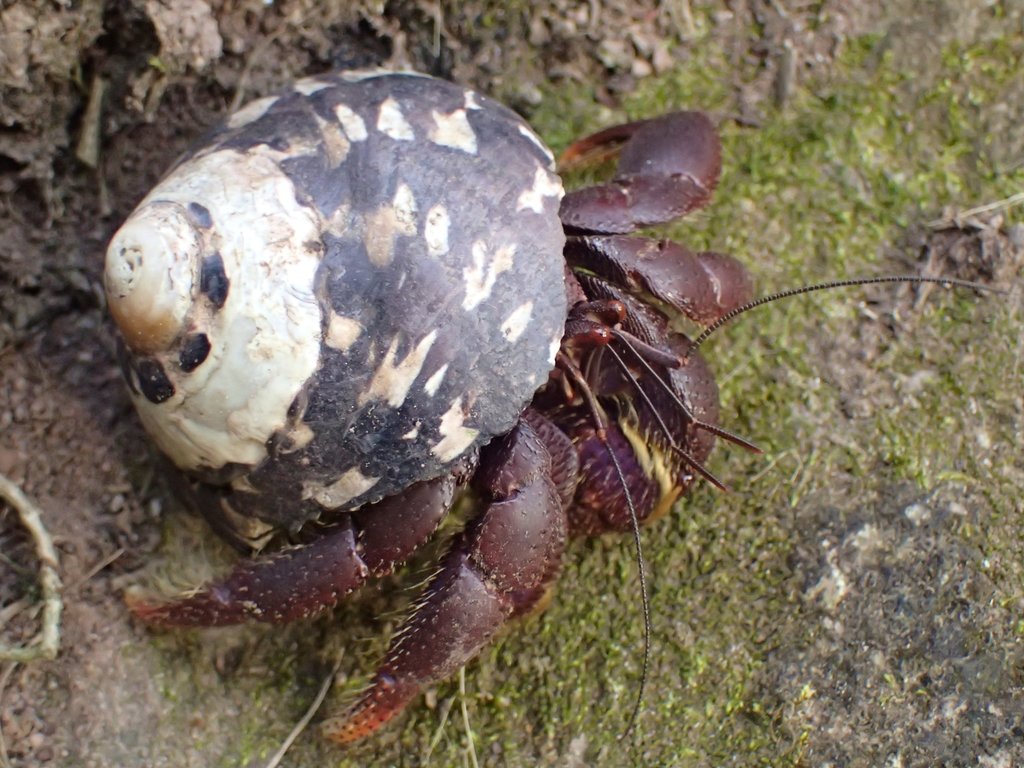On Land: Crustaceans
Caribbean land hermit crab
Coenobita clypeatus
Jumplinks:
About
You’re hiking one of Saba’s many forest trails. Suddenly, some rocks start moving next to your feet. Upon closer inspection, you notice they aren’t rocks, they’re shells — and they have inhabitants. Congrats, you’ve just stumbled upon some of Saba’s Caribbean land hermit crabs!
Crabs are typically associated with water and coastal areas, but these crabs are often found in much drier areas with significant tree cover. They still have gills, like all other crabs, but they’re modified to be able to breathe humid air that they actually keep in their shells. These hermit crabs can be found in many colors (from red, to yellow, to purple and brown), and they make their homes in the shells of snail species — which means there are lots of different ways a land hermit crab can look, They’re even been found living in homes made of manmade materials.
These crabs are primarily plant-eaters, and you can find them feasting in large groups on fallen fruits and other vegetable matter on the forest floor. Not ones to pass up nutrients, though, they’re also known to scavenge on dead animal remains and even dung when available, keeping Saba’s understories spick-and-span.
Hermit crabs sit pretty low on the food chain, but can protect themselves in a couple of ways. First, they can pull their entire body into their shell when they sense a threat, with only the tips of their two largest claws exposed. (The only downside? This defense removes their ability to hold tightly to surfaces, so hikers who startle these crabs on sloped ground may accidentally trigger a hermit crab avalanche, as occupied shells tumble down hills.) Additionally, they can use their two large claws to give any threats a painful pinch. They mostly reserve this tactic for other hermit crabs, though, such as when fighting over a larger shell.
Header image by Kai Wulf.
This species is:
Native
Why that matters:
Native species are those that evolved in the region naturally, without human influence. That means they’re specifically adapted to Saba’s habitat, and play a key role in island biodiversity. When we lose native species, gaps appear in the ecosystem. That leads to cascades of additional extinctions, and to the loss of the ecosystem services (food, clean air and water, flood and coastal protections, and more) that we humans rely on.
iNaturalist Observations
Where locals, researchers, and visitors have seen this species.
Google / Imagery © 2023 CNES / Airbus, Landsat / Copernicus, Maxar Technologies, U.S. Geological Survey, iNaturalist Map data @2023
This map shows geotagged observations of this species made on iNaturalist, the world’s largest community-science platform.
iNat depends on people like you. By uploading photos of species you see in the wild, you can easily learn more about them — while also contributing critical data used by scientists and conservation-managers around the globe.
See something odd?
Observations of land species in water:
Connectivity can affect how accurate location services are, and in the case of endangered species, location is often automatically obscured.Missing observations:
Your help is needed to collect more data for this species!
Ask a Scientist
Question: Why do Caribbean land hermit crabs have shells? How do they get them?
Answer: The protective carapace of Caribbean land hermit crabs only covers their head and thorax, leaving their soft abdomens vulnerable to both predators and dehydration. They protect their soft, hook-shaped bellies by inhabiting the shells of dead marine snails, the best size and shape of which they often compete fiercely for. These land crabs have the ability to detect the odors of both potential food and of recently dead hermit crabs from whom they might “inherit” a perfect shell.
Chrissy Piotrowski
Invertebrate Zoology Collections Manager, California Academy of Sciences
Related Content
Fringed star orchid
On Land: Plants
Soursop
On Land: Plants









